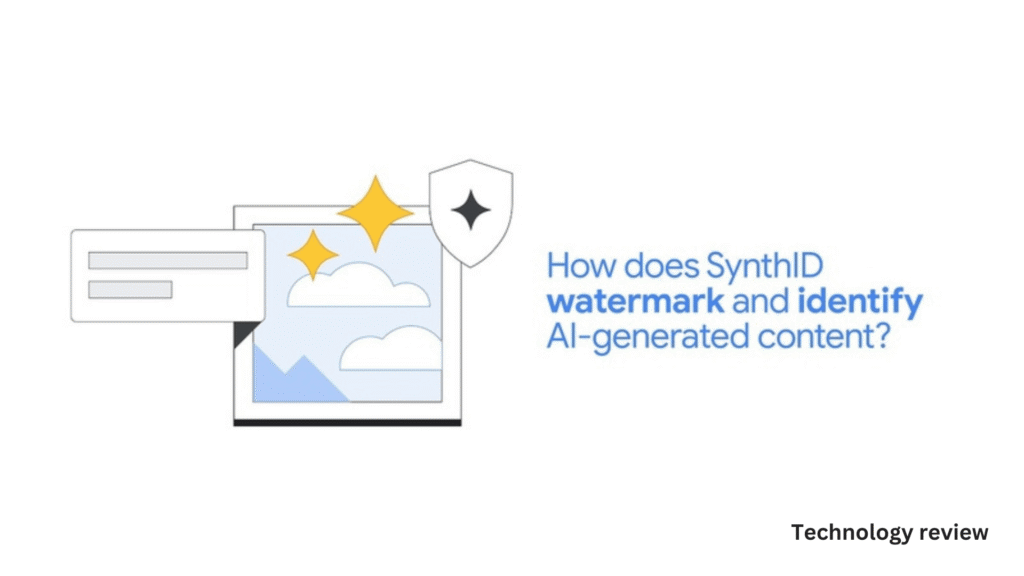SynthID: With the rise of artificial intelligence (AI), the line between human-created content and AI-generated material is becoming increasingly blurred. AI models, particularly large language models (LLMs) like OpenAI’s GPT and Google DeepMind’s Gemini, are now capable of producing text that closely mimics human writing. This remarkable advancement, while promising, also poses significant ethical and societal challenges, particularly in combating misinformation and ensuring accountability. In response to these concerns, Google DeepMind has developed SynthID, a groundbreaking tool that embeds invisible watermarks in AI-generated text. This innovation offers a new way for developers, businesses, and the public to detect whether content has been produced by an AI system.
SynthID is part of a family of watermarking tools developed by Google DeepMind for generative AI outputs. Initially, these tools focused on AI-generated images, later expanding to video and now text. This technology comes at a critical time, as the demand for transparency in AI-generated content continues to grow, particularly in industries such as media, education, and marketing, where distinguishing between AI-created and human-created content is increasingly essential.
The Growing Need for AI Transparency
The proliferation of AI-generated content has revolutionized how we create and consume information. From generating articles and essays to creating personalized marketing materials, AI-powered systems have significantly streamlined content creation processes. However, this rapid adoption has also sparked concerns about the potential misuse of AI, particularly when it comes to spreading misinformation, manipulating public opinion, and infringing on intellectual property rights.
AI-generated text can be used for both beneficial and harmful purposes. On one hand, AI tools can help automate tasks, provide insights, and even assist in creative endeavors like writing poetry or developing dialogue for virtual characters. On the other hand, AI-generated text can be used maliciously to spread disinformation, create deepfakes, or engage in fraudulent activities. This dual-edged sword of AI calls for more robust methods to ensure accountability and transparency in its use.
As AI continues to advance, the need to distinguish between human-generated and AI-generated content has become paramount. This is where SynthID plays a critical role. By embedding an invisible watermark into the text generated by AI systems, SynthID allows for the easy detection of AI-generated content, helping individuals and organizations combat the potential harms associated with AI-generated misinformation.
How SynthID Works: The Science Behind AI Watermarking
At its core, SynthID works by embedding a watermark within the AI-generated text at the point of creation. Unlike traditional watermarks used in images and videos, which are visible to the naked eye, SynthID’s watermark is invisible. It is embedded directly into the probability structure of the text generated by large language models.

To understand how SynthID works, it’s important to first grasp how language models generate text. Language models, like Google DeepMind’s Gemini, break down language into smaller units called “tokens.” Tokens can be words, characters, or parts of a word, and the model predicts the next token in a sequence based on the context of the previous tokens. For each token, the model assigns a probability score that reflects how likely it is to appear next in the sequence. For example, in the sentence “The cat is on the,” the token “mat” would have a higher probability of being the next word than “moon” based on common language patterns.
SynthID takes advantage of this token prediction process by subtly altering the probabilities of certain tokens at the moment of generation. These small changes create a unique watermark that remains embedded within the structure of the text. The watermark does not alter the meaning, coherence, or quality of the generated text, ensuring that the AI output is still natural and accurate.
Detecting the Watermark: How SynthID Ensures Transparency
Once the watermark is embedded, detecting whether a piece of text has been generated by an AI system involves comparing the actual probability scores of tokens with the expected scores for unwatermarked text. The presence of the watermark is revealed by these subtle differences in token probabilities. Since the watermark is invisible and embedded within the text’s structure, it does not impact the readability or flow of the content, making it imperceptible to human readers.
SynthID’s watermarking system is designed to be resilient against minor modifications to the text. For example, light editing or rewriting may not remove the watermark, allowing the system to detect AI-generated text even after small changes have been made. However, SynthID is less effective when the text undergoes significant transformations, such as being heavily rewritten or translated into another language. In such cases, the watermark may become less detectable, presenting a challenge for consistent detection across different forms of content.
The Real-World Application of SynthID
Google DeepMind has already tested SynthID in real-world applications, specifically in its Gemini products, which include AI chatbots and content generation tools. The watermark was applied to more than 20 million AI-generated chatbot responses, allowing Google DeepMind to analyze the effectiveness of the watermark in live environments. User feedback was collected through a system that allowed users to rate the quality of chatbot responses with a thumbs-up or thumbs-down.
The results of this large-scale experiment, published in Nature, demonstrated that users did not notice any difference in quality, accuracy, or creativity between watermarked and non-watermarked text. This finding suggests that SynthID’s watermarking system does not compromise the performance of AI-generated text. The watermark is invisible to users and does not affect their interaction with AI tools, preserving the quality of the generated content while adding a layer of accountability.
Limitations of SynthID: Challenges in AI Watermarking
Despite its innovative design, SynthID does have limitations, particularly when it comes to detecting AI-generated text in specific scenarios. For instance, SynthID is most effective when applied to creative or conversational text, where there are multiple possible outcomes for each token. However, the tool struggles in more deterministic tasks, such as factual question-answering or code generation, where there is a limited number of correct responses. In these cases, the probability scores for tokens are more rigid, leaving fewer opportunities for the watermark to be embedded without impacting the correctness of the content.
Additionally, SynthID’s watermarking system is less reliable when AI-generated text is translated into other languages or undergoes significant rewriting. For example, if an AI-generated article is translated from English to Spanish, the original token probabilities may no longer apply, making the watermark difficult to detect. Similarly, if a user rewrites the text extensively, the watermark may be erased or altered beyond recognition.
Soheil Feizi, an associate professor at the University of Maryland and an expert in AI watermarking, acknowledges these challenges. According to Feizi, achieving reliable and imperceptible watermarking in AI-generated text is inherently difficult, especially in scenarios where outputs are highly predictable. Despite these limitations, Feizi views SynthID as a positive step forward in the quest for AI transparency.
Ethical Implications: SynthID’s Role in Responsible AI Development
The introduction of SynthID represents a significant advancement in responsible AI development. As AI-generated content becomes more prevalent, tools like SynthID are essential for ensuring that AI is used ethically and transparently. By allowing developers and organizations to detect AI-generated content, SynthID can help mitigate some of the risks associated with AI, such as the spread of misinformation, fraud, and unauthorized use of AI tools.
Moreover, SynthID’s open-source availability marks an important milestone in AI ethics. By making the tool freely available on platforms like Hugging Face, Google DeepMind is encouraging the broader AI community to adopt watermarking technology and contribute to its improvement. João Gante, a machine-learning engineer at Hugging Face, praises the decision to open-source SynthID, noting that it allows developers to incorporate watermarking into their models with ease. This accessibility could lead to widespread adoption of watermarking, further promoting responsible AI use across industries.

However, watermarking is not a silver bullet for AI ethics. Irene Solaiman, head of global policy at Hugging Face, points out that watermarking is just one component of a broader ecosystem of safeguards needed to ensure ethical AI use. She likens it to fact-checking in human-generated content, which, while useful, has varying degrees of effectiveness depending on the context. Similarly, watermarking alone cannot solve all the challenges posed by AI, particularly when it comes to deepfakes or malicious use of language models.
Looking Ahead: The Future of AI Watermarking
As AI technology continues to evolve, so too will the methods used to ensure its transparency and ethical use. SynthID represents a promising step forward, but it is likely just the beginning of a broader movement toward responsible AI development. Future advancements in AI watermarking may focus on improving the detection of watermarks in translated or heavily modified text, as well as expanding the tool’s capabilities to other types of content, such as audio or interactive media.
Moreover, as AI becomes more integrated into everyday life, there may be increasing demand for regulations and standards that mandate the use of watermarking in AI-generated content. Governments, industries, and academic institutions will need to work together to establish best practices for AI watermarking, ensuring that tools like SynthID are used effectively and responsibly.
Conclusion: SynthID’s Role in Shaping the Future of AI
Google DeepMind’s SynthID is a groundbreaking tool that addresses one of the most pressing challenges in the field of AI: distinguishing between human-generated and AI-generated content. By embedding an invisible watermark in AI-generated text, SynthID provides a way for developers, businesses, and the public to ensure transparency and accountability in the use of AI.
While SynthID is not without its limitations, it represents a significant step forward in responsible AI development. Its open-source availability encourages collaboration and innovation within the AI community, while its real-world applications demonstrate its effectiveness in preserving the quality of AI-generated content. As AI continues to shape the future of content creation, tools like SynthID will play a crucial role in ensuring that AI is used ethically and responsibly.



